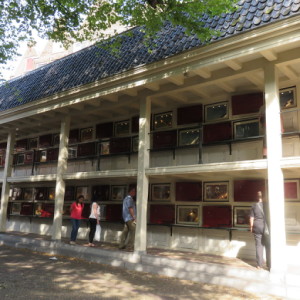Remains of the day
This is a 18th century water pump that caught my eye in the courtyard of the old civic orphanage where the Amsterdam museum is now housed. The museum itself surely contains a rich fund of material about the history of the city but it's presented in such a way that my interest wasn't really caught until I went outside. The city orphanage was a closed world that provided overall care, education and training so that the children would be able to make their own way in the world when they left. A bank of lockers ranged along one side of the courtyard (see extra) was where the boys kept the tools of the trade each was learning. The girls were just trained up in domestic work of course.
The pump drew on a huge reservoir of rain water funnelled down from the steep roofs and stored underground: the tank in the cellar below had 12 compartments.
I have started to think about Amsterdam as a sort of water sandwich. On the surface are the canals, lakes and waterways all connecting with each other and eventually with the sea. Under the houses was the stored drinking water but below that is a layer of wet peaty ground so liable to subsidence that all buildings had to be constructed on wooden piles that reach 40-60 feet down to where there is a footing of firm sand. So long as they remain under water the piles can last for centuries.
The day had a watery start with an exploration, by bike, of some local parks with ponds and lakes frequented by birds. Like London, Amsterdam has parakeets, but as well as the ubiquitous herons and coots, most captivating was family of great crested grebe, the single youngster being coached in diving for food.
The day ended with our own search for nourishment in the De Pijp area of the city. Shabby-chic now, it retains some lovely old architectural features from a century ago and is also the place to find restaurants serving East Asian food - which went down well after a long day.
The day illustrated here.


Comments
Sign in or get an account to comment.


